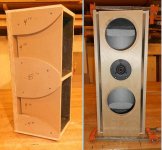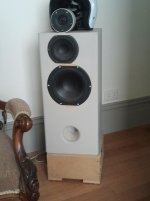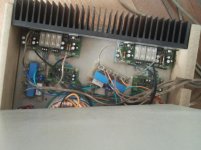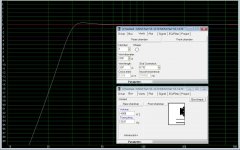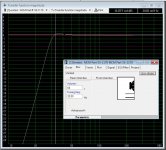Yes, there is a good reason why that's a bad idea.
Aluminum will change the inductor values quite a bit, as you can see here:
Placement of coils in crossover networks
Plastic, wood or fiberglass would be a better choice, though some care should be given to the heat that resistors can generate, I have seen scorched wood and fiberglass and melted plastic in a number of designs.
Wow. I didn't think aluminum would have an effect. Steel maybe. Good to know.
If you have the aluminum plates and want to use them, just put an insulating layer between it and the xo. Do you have a thin rubber sheet? Maybe a 1/8" or 1/4" piece of hardboard would also do the trick. You also want to make sure you have a good seal between the plate and the cabinet - the only air going in and out of the cabinet should be through the port. A simple gasket of some kind should work.
Maybe just leave the xo out board for now...can save hours of work later on.
I've been using an old 1/2" cork board as a base for parts, and just zip tie together.
I'm sure a scope if fine, sounds heavy/clunky though, can simply use a volt meter and note the voltages with a sweep test.
Once you get the box together the speaker peak will be the valley. The low and upper peaks should be equal - if this works, you know you've done something right 😀
Once you get the hang of it, you can get creative with ports - pic example.
I've been using an old 1/2" cork board as a base for parts, and just zip tie together.
I'm sure a scope if fine, sounds heavy/clunky though, can simply use a volt meter and note the voltages with a sweep test.
Once you get the box together the speaker peak will be the valley. The low and upper peaks should be equal - if this works, you know you've done something right 😀
Once you get the hang of it, you can get creative with ports - pic example.
Attachments
If you have the aluminum plates and want to use them, just put an insulating layer between it and the xo. Do you have a thin rubber sheet? Maybe a 1/8" or 1/4" piece of hardboard would also do the trick. You also want to make sure you have a good seal between the plate and the cabinet - the only air going in and out of the cabinet should be through the port. A simple gasket of some kind should work.
As a newbie here, and I have made a fool of myself exposing how little I know of speakers this is hard for me to do. As weltersys pointed out in his link Placement of coils in crossover networks , proximity to metal affects the coil inductance. Something that is an electrical insulator such as rubber does not mean its an insulator of electromagnetic waves. My thought was by mounting the Xo on 1/2" or so spacers there would be no problem. The examples in weltersys, post about 10mm plywood spacing prove my thoughts wrong.
What did I get myself into
Tony
Tony - man don't beat yourself up.
You're doing fine. There is no prerequisite for knowledge required before asking questions. It would sort of undermine the need for asking questions wouldn't it?
And look, you just taught me something which I hadn't thought through well enough. Good on ya.
You're doing fine. There is no prerequisite for knowledge required before asking questions. It would sort of undermine the need for asking questions wouldn't it?
And look, you just taught me something which I hadn't thought through well enough. Good on ya.
I do have just about every type of woodworking tool and I work as an electronics engineer.
Given your skills in an field important to audio, have you considered building active speakers? It would harness your skills and, quite probably, make the build easier than having to deal with a passive crossover. Many experienced forum members run active and swear by it, as do I.
The (many) people I invite to hear my speakers are gob-smacked to hear how good very ordinary looking speakers can sound, and I am no EE.
Many things are made easier; integration of the drivers with no need to worry about different sensitivities, no need to concern with impedance curves, baffle step compensation can be done at line level, any necessary (but should not be if drivers are chosen well) EQ is also at line level, large and expensive inductors are not necessary AND you get the considerable benefit of active, loud, clean and undistorted sound. (As usual, the flaming will start with blah this and blah that.)
Please do some research? I think you will be pleasantly surprised. It is more electronic work and, yes, it is slightly more complicated but I doubt that will trouble you much, if at all.
Abs
Attachments
Yes Tony, remember this is relaxing 😀
The forum is a idea- round table, take in what you can and make decisions based on that.
E.G.:
Got lost with the box plans but simmed the crazy little woofer in WinISD, impressive bass in a 4.8ft3 box, port would be 4" x 4" but we can sim a slot-port in seconds.
What size box are you building - 3cf?
The forum is a idea- round table, take in what you can and make decisions based on that.
E.G.:
Got lost with the box plans but simmed the crazy little woofer in WinISD, impressive bass in a 4.8ft3 box, port would be 4" x 4" but we can sim a slot-port in seconds.
What size box are you building - 3cf?
Attachments
Yes Tony, remember this is relaxing 😀
The forum is a idea- round table, take in what you can and make decisions based on that.
E.G.:
Got lost with the box plans but simmed the crazy little woofer in WinISD, impressive bass in a 4.8ft3 box, port would be 4" x 4" but we can sim a slot-port in seconds.
What size box are you building - 3cf?
I'm taking in all I can and I'm starting to actually understand some of it. I'm aiming for 2 cu ft. Anything bigger than that I'd probably need to pick up another sheet of plywood and the box would just get to clunky and heavy for my tastes. Whats a slot - port?
Thanks for the info
Tony
Given your skills in an field important to audio, have you considered building active speakers? It would harness your skills and, quite probably, make the build easier than having to deal with a passive crossover. Many experienced forum members run active and swear by it, as do I.
The (many) people I invite to hear my speakers are gob-smacked to hear how good very ordinary looking speakers can sound, and I am no EE.
Many things are made easier; integration of the drivers with no need to worry about different sensitivities, no need to concern with impedance curves, baffle step compensation can be done at line level, any necessary (but should not be if drivers are chosen well) EQ is also at line level, large and expensive inductors are not necessary AND you get the considerable benefit of active, loud, clean and undistorted sound. (As usual, the flaming will start with blah this and blah that.)
Please do some research? I think you will be pleasantly surprised. It is more electronic work and, yes, it is slightly more complicated but I doubt that will trouble you much, if at all.
Abs
Wow. I never even heard of active speakers. I assume then it like a sub-woofer with amps built right into the speaker and it just gets fed by the line outs of the amp.
Tony
Maybe just leave the xo out board for now...can save hours of work later on.
I've been using an old 1/2" cork board as a base for parts, and just zip tie together.
I'm sure a scope if fine, sounds heavy/clunky though, can simply use a volt meter and note the voltages with a sweep test.
Once you get the box together the speaker peak will be the valley. The low and upper peaks should be equal - if this works, you know you've done something right 😀
Once you get the hang of it, you can get creative with ports - pic example.
Yeah. I'll leave the crossover outside the box initially for testing. Newer scopes are not heavy or clunky. I have a Tektronix TDA1002. One of their cheapest ones. Its probably double the size of a standard DMM and weighs no more than 4 or 5 lbs. Quite handy. On the other hand I have an old Tektronix 465. That's a beast.
Tektronix TDS1002 - Digital Oscilloscopes
Tony
Tony,
Some info here for background:
Active speakers have an advantage in that amplifiers being constant-voltage drive, they do not care about some of the impedance issues we have to deal with in passive network speakers. The crossover drives a predictable (active) load. It is easier and cheaper to do very complex equalization actively. (You can boost, not just cut!) Of course, you need a lot more amps.
So, why are most speakers not active if it is inherently better? The consumer market pricing is my best guess. For an example of active, look at Linkwitz Orion build notes. In pro PA work and a great many pro studio monitors they go active as the total system cost and performance are important, not the consumer expectations. Companies like Meridian have done active for a long time. Very nice but out of my price bracket.
You still need to master the bass alignment and other box related issues like edge diffraction. You will still need to learn acoustic measuring. Get building!
Full disclosure: I have a stack of Parasound amps saved to do my living room mains, but I guess it is such a challenge to pull off a really sweet design with passive networks that I am stuck there. The engineer side of me says I really should reassess this.
Some info here for background:
Active speakers have an advantage in that amplifiers being constant-voltage drive, they do not care about some of the impedance issues we have to deal with in passive network speakers. The crossover drives a predictable (active) load. It is easier and cheaper to do very complex equalization actively. (You can boost, not just cut!) Of course, you need a lot more amps.
So, why are most speakers not active if it is inherently better? The consumer market pricing is my best guess. For an example of active, look at Linkwitz Orion build notes. In pro PA work and a great many pro studio monitors they go active as the total system cost and performance are important, not the consumer expectations. Companies like Meridian have done active for a long time. Very nice but out of my price bracket.
You still need to master the bass alignment and other box related issues like edge diffraction. You will still need to learn acoustic measuring. Get building!
Full disclosure: I have a stack of Parasound amps saved to do my living room mains, but I guess it is such a challenge to pull off a really sweet design with passive networks that I am stuck there. The engineer side of me says I really should reassess this.
Don't worry about fancy ports. They all work the same. Mass and friction. The sim tools have the equations for simple round ports. Later you can decide if the aesthetics or build methods suggest playing with funny ports. I have done many, but just go back to PVC pipe as it is cheap and works very well. Some fancy store bought ports are so thin they can cause resonance issues.
I bet you have figured out speaker design is full of old-wives tails, obsolete ideas we won't give up and a whole lot of snake oil. Being an engineer you have an advantage many beginners don't in being to cut through a lot of the bull. You already can understand magic binding posts don't a great speaker make. 🙂
I bet you have figured out speaker design is full of old-wives tails, obsolete ideas we won't give up and a whole lot of snake oil. Being an engineer you have an advantage many beginners don't in being to cut through a lot of the bull. You already can understand magic binding posts don't a great speaker make. 🙂
Well based on the education I got here and things that ODougbo, jReave ,weltersys and tvrgeek (and others) said, I have a change of plans here. Back at the beginning of this post it was ODougbo that said these drivers would shake the walls in a ported setup. From there some of the others I mentioned, educated me more on ported systems and provided some plots. I played around with winisd and learned even more.
I had some leftover lengths of engineered hard wood flooring, 5/8 thick 8 inches wide and over the weekend I slapped together a box that ends up being about 26L with a 2 inch diameter pvc port 4 inches long.
I used the Vifa tweeter with just a cap on it and just an inductor going to a single MCM junk driver. Right now don't care or know what the xo F is. I must have a tin ear because this setup sounds not too bad to me. At low volume it sounds rich with a good amount of bass (could use more). At high volume its clean and punchy (one speaker almost shakes the walls) but it sounds a little shouty or screechy. Almost good enough for me.
Anyway I'm going to go with a single driver in a 55L box. According to my education I got here, that should give me a good deal more bass extension. A better crossover setup would probably go a long way as well. If anyone has some further suggestions I'm all ears.
I think there are a lot of people in the world who would be satisfied with the sound from a 1960's 7 transistor radio. Then there are others who just want something rich and pleasing sounding even if not perfect. Then there are those who demand all out perfection. I fall into the middle group. On top of that, and I could be wrong, I'd be willing to bet that the all out, perfectly tweaked speakers may not sound perfect with every type of music.
Tony
I had some leftover lengths of engineered hard wood flooring, 5/8 thick 8 inches wide and over the weekend I slapped together a box that ends up being about 26L with a 2 inch diameter pvc port 4 inches long.
I used the Vifa tweeter with just a cap on it and just an inductor going to a single MCM junk driver. Right now don't care or know what the xo F is. I must have a tin ear because this setup sounds not too bad to me. At low volume it sounds rich with a good amount of bass (could use more). At high volume its clean and punchy (one speaker almost shakes the walls) but it sounds a little shouty or screechy. Almost good enough for me.
Anyway I'm going to go with a single driver in a 55L box. According to my education I got here, that should give me a good deal more bass extension. A better crossover setup would probably go a long way as well. If anyone has some further suggestions I'm all ears.
I think there are a lot of people in the world who would be satisfied with the sound from a 1960's 7 transistor radio. Then there are others who just want something rich and pleasing sounding even if not perfect. Then there are those who demand all out perfection. I fall into the middle group. On top of that, and I could be wrong, I'd be willing to bet that the all out, perfectly tweaked speakers may not sound perfect with every type of music.
Tony
Tony, here's the 55-1170 in a 68 liter box, port would be 3" x 5.5.
As many will tell you, "the box is the easy part"
I'm not sold on the $5 - $10 woofer, guessing the primary goal/design was a plastic mount G.W.B. In-Wall-Speaker. But this a hobby and experimenting is a part of it.
Steve did a few xo's for this, and posted a pic of a tallish box; go with those ideas, they are very good.
As many will tell you, "the box is the easy part"
I'm not sold on the $5 - $10 woofer, guessing the primary goal/design was a plastic mount G.W.B. In-Wall-Speaker. But this a hobby and experimenting is a part of it.
Steve did a few xo's for this, and posted a pic of a tallish box; go with those ideas, they are very good.
Attachments
The next thing you need to know about if baffle step loss and diffraction. These are usually compensated for in the xo and without them you will be lacking bass and may end up with a peak in the mids or upper mids (ie. shouty) - it all depends on baffle width.
I just went over a little about this with some links in this thread - ihttp://www.diyaudio.com/forums/multi-way/247291-noob-5-1-ambitions-3.html
Those woofers also have some peaking at about 5000Hz that may or may not be getting taken care of with your single inductor.
I just went over a little about this with some links in this thread - ihttp://www.diyaudio.com/forums/multi-way/247291-noob-5-1-ambitions-3.html
Those woofers also have some peaking at about 5000Hz that may or may not be getting taken care of with your single inductor.
The next thing you need to know about if baffle step loss and diffraction. These are usually compensated for in the xo and without them you will be lacking bass and may end up with a peak in the mids or upper mids (ie. shouty) - it all depends on baffle width.
I just went over a little about this with some links in this thread - ihttp://www.diyaudio.com/forums/multi-way/247291-noob-5-1-ambitions-3.html
Those woofers also have some peaking at about 5000Hz that may or may not be getting taken care of with your single inductor.
I have very little on hand in the way of crossover parts, but using what I have, I put 0.6 mH - 6.8 uF for the low pass , and 0.4 mH - 8.4 uF for the high pass. I know its all wrong but it sounded much better. I then added a 10 ohm 1/4w resistor in series with the tweeter (1/4W is all I had). Sounded even better but the first time I played it loud the resistor smoked. I'm just experimenting and learning. I think when these are in a much bigger box I'm going to like them.
I'm not sure but I get the feeling I would not hear the difference with or without baffle step compensation since I do not sit right in front of the speakers and my speakers are kiddie cornered at each end of the room. I get a little bit of the gist of baffle step but I just have to ask - Why not just use the bass and treble controls to overcome it? Or is that blasphemy and I should be burned at the stake for saying it?
Thanks for the info
Tony
Tony,I get a little bit of the gist of baffle step but I just have to ask - Why not just use the bass and treble controls to overcome it?
Nothing wrong with using EQ to correct for frequency response deviations, DSP correction is now quite common, and can do a lot more than bass and treble controls, and the cost is approaching that of good passive components.
The response of a cabinet depends very much on placement in relation to boundaries, a baffle step compensation for free space, well away from walls won't be correct for the same cabinet used in a bookshelf.
Tony, here's the 55-1170 in a 68 liter box, port would be 3" x 5.5.
As many will tell you, "the box is the easy part"
I'm not sold on the $5 - $10 woofer, guessing the primary goal/design was a plastic mount G.W.B. In-Wall-Speaker. But this a hobby and experimenting is a part of it.
Steve did a few xo's for this, and posted a pic of a tallish box; go with those ideas, they are very good.
So would anyone recommend this woofer instead? Seems to like big boxes like the cheap MCM woofer. If it is in fact better I will get them just so I can hear the difference after hearing the MCM's (or actually see if my tin ears can tell the difference)
Visaton W170S-8 6.5" Woofer with Treated Paper Cone 8 Ohm | 292-568.
Whats a G.W.B.?
Tony
With baffle step loss, you'll lose the bass even if you're not sitting right in front of it and since you said you don't hear the bass quite that well I would figure that getting this compensation done right is going to matter for you.
You could easily just use the bass control on your receiver but it will only be accurate if the bass boost and the start of the baffle step loss occur at the same frequency. I measured on 1 of my receivers and the bass control starts boosting at 500Hz for a total of 6dB on the bottom end which would correspond to the baffle step loss on about a 9" wide baffle. That could actually work out pretty well for you. I'm not sure if other receivers do the exact same thing. I would think an EQ might be more flexible and do a more accurate job.
On paper that Visaton looks good but I have no clue about the sound quality.
I would suggest this one instead - Dayton Audio DA175-8 7" Aluminum Cone Woofer | 295-335. Its specs give it a similar response to the Visaton and it has very decent distortion measurements for the price.
See the 1st product review of the Dayton down lower on the above link - most informative for you I think. And see Zaph|Audio too to see how the driver stacks up against others (although much of what he says may be too technical for you, it's a great sight for learning - there are a lot more pages than just that one).
You could easily just use the bass control on your receiver but it will only be accurate if the bass boost and the start of the baffle step loss occur at the same frequency. I measured on 1 of my receivers and the bass control starts boosting at 500Hz for a total of 6dB on the bottom end which would correspond to the baffle step loss on about a 9" wide baffle. That could actually work out pretty well for you. I'm not sure if other receivers do the exact same thing. I would think an EQ might be more flexible and do a more accurate job.
On paper that Visaton looks good but I have no clue about the sound quality.
I would suggest this one instead - Dayton Audio DA175-8 7" Aluminum Cone Woofer | 295-335. Its specs give it a similar response to the Visaton and it has very decent distortion measurements for the price.
See the 1st product review of the Dayton down lower on the above link - most informative for you I think. And see Zaph|Audio too to see how the driver stacks up against others (although much of what he says may be too technical for you, it's a great sight for learning - there are a lot more pages than just that one).
+1
The DA175-8 driver review looks believable; 1.2 cubic foot floor-stander 😉
Tony, if you place a PE order, fill the cart to $100 - free ship: woofers are heavy so can save there (vs. ordering from other sites). Think tweeters, coils/caps/resistors, damping material, black screws... Don't forget the coupon codes that can easily be found on the web.
Thanks jReaves for the Zaph link, will bookmark it.
G.W.B.-Drywall
The DA175-8 driver review looks believable; 1.2 cubic foot floor-stander 😉
Tony, if you place a PE order, fill the cart to $100 - free ship: woofers are heavy so can save there (vs. ordering from other sites). Think tweeters, coils/caps/resistors, damping material, black screws... Don't forget the coupon codes that can easily be found on the web.
Thanks jReaves for the Zaph link, will bookmark it.
G.W.B.-Drywall
- Status
- Not open for further replies.
- Home
- Loudspeakers
- Multi-Way
- New here with a question
